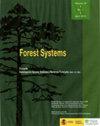一种评估Nelder轮上树木竞争的新方法
IF 0.7
4区 农林科学
Q3 FORESTRY
引用次数: 0
摘要
研究目的:建立一个描述不同密度桉树无性系竞争的指标;同时,评估Nelder车轮(NWs)上克隆的生产力。研究区域:10个桉树无性系,分布在巴西托坎廷斯州北部的9个西北部。材料和方法:建立了一个新的竞争指数,即NW上不同位置的采样单元的几何面积和平均横截面积与中心单元的比例。此外,还测试了两个与距离相关的指数,以评估它们在不同间距下的性能。评估了竞争指数与变量身高、直径、体积和横截面积、平均距离和死亡率之间的相关性。为了检查克隆之间的生产力差异,我们使用了MANOVA和判别分析。主要结果:Alba-Péllico指数比其他评估指数更好地了解了树木之间的竞争关系,并更好地解释了NWs的竞争过程。在密度较低的位置,克隆之间基底面积的变化证实了每个克隆的特征或该位置可能的干扰,因为在这种情况下,它们不受间距和竞争的影响。这表明,在最密集位点的直径、基部面积和体积方面,竞争比位点和基因型的其他特征更具影响力。研究重点:Alba-Péllico指数的特征表明,很好地解释了树木之间的竞争关系,因为结果在0和1之间变化,越接近零,竞争就越小或不存在。本文章由计算机程序翻译,如有差异,请以英文原文为准。
A new approach to assessing competition from trees on Nelder wheels
Aim of the study: To develop an index to describe the competition of trees of Eucalyptus spp. clones in different densities; also, to evaluate the productivity of the clones on Nelder wheels (NWs).
Area of study: Ten Eucalyptus spp. clones distributed in nine NWs, located in the northern state of Tocantins, Brazil.
Material and methods: A new competition index was formulated as the ratio of geometric areas and average cross-sectional areas of sampling units from different locations on the NW referenced to a unit taken in the center of it. Besides, two distance-dependent indices were tested to evaluate their performance in different spacings. The correlation between the competition indices and the variables height, diameter, volume and cross-sectional area, average distance and mortality percentage was evaluated. To check the difference in productivity between the clones we used MANOVA and discriminant analysis.
Main results: The Alba-Péllico index provides a better understanding of the competitive relationship between trees, as well as a better explanation of the competitive process in the NWs than the other indices evaluated. The variation in the basal area between the clones in the less dense locations, substantiates the characteristics of each clone or possible interferences of the location since in this condition they are free from the influence of spacing and competition. This shows that competition is more influential than other characteristics of sites and genotypes in the behavior in diameter, basal area and volume in the densest sites.
Research highlights: The characteristics of the Alba-Péllico index indicate good interpretation to understand the competitive relationship among trees since the results vary between 0 and 1, and the closer to zero the smaller or non-existence of competition.
求助全文
通过发布文献求助,成功后即可免费获取论文全文。
去求助
来源期刊

Forest Systems
FORESTRY-
CiteScore
1.40
自引率
14.30%
发文量
30
审稿时长
6-12 weeks
期刊介绍:
Forest Systems is an international peer-reviewed journal. The main aim of Forest Systems is to integrate multidisciplinary research with forest management in complex systems with different social and ecological background
 求助内容:
求助内容: 应助结果提醒方式:
应助结果提醒方式:


